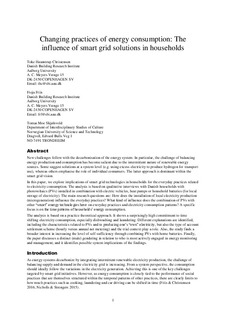| dc.contributor.author | Christensen, Toke Haunstrup | |
| dc.contributor.author | Friis, Freja | |
| dc.contributor.author | Skjølsvold, Tomas Moe | |
| dc.date.accessioned | 2017-11-17T10:02:43Z | |
| dc.date.available | 2017-11-17T10:02:43Z | |
| dc.date.created | 2017-06-19T08:27:18Z | |
| dc.date.issued | 2017 | |
| dc.identifier.citation | Eceee ... summer study proceedings. 2017, 2021-2030. | nb_NO |
| dc.identifier.issn | 1653-7025 | |
| dc.identifier.uri | http://hdl.handle.net/11250/2466857 | |
| dc.description.abstract | New challenges follow with the decarbonisation of the energy system. In particular, the challenge of balancing energy production and consumption has become salient due to the intermittent nature of renewable energy sources. Some suggest solutions at a system level (e.g. using excess electricity to produce hydrogen for transport use), whereas others emphasise the role of individual consumers. The latter approach is dominant within the smart grid vision.
In this paper, we explore implications of smart grid technologies in households for the everyday practices related to electricity consumption. The analysis is based on qualitative interviews with Danish households with photovoltaics (PVs) installed in combination with electric vehicles, heat pumps or household batteries (for local storage of electricity). The main research questions are: How does the installation of local electricity production (microgeneration) influence the everyday practices? What kind of influence does the combination of PVs with other “smart” energy technologies have on everyday practices and electricity consumption patterns? A specific focus is on the time patterns of households’ energy consumption.
The analysis is based on a practice theoretical approach. It shows a surprisingly high commitment to time shifting electricity consumption, especially dishwashing and laundering. Different explanations are identified, including the characteristics related to PVs and to producing one’s “own” electricity, but also the type of account settlement scheme (hourly versus annual net metering) and the trial context play a role. Also, the study finds a broader interest in increasing the level of self-sufficiency through combining PVs with home batteries. Finally, the paper discusses a distinct (male) gendering in relation to who is most actively engaged in energy monitoring and management, and it identifies possible system implications of the findings | nb_NO |
| dc.language.iso | eng | nb_NO |
| dc.publisher | European Council for an Energy Efficient Economy, ECEEE | nb_NO |
| dc.relation.uri | http://proceedings.eceee.org/visabstrakt.php?event=7&doc=9-162-17 | |
| dc.title | Changing practices of energy consumption: The influence of smart grid solutions in households | nb_NO |
| dc.type | Journal article | nb_NO |
| dc.type | Peer reviewed | nb_NO |
| dc.description.version | acceptedVersion | nb_NO |
| dc.source.pagenumber | 2021-2030 | nb_NO |
| dc.source.journal | Eceee ... summer study proceedings | nb_NO |
| dc.identifier.cristin | 1476954 | |
| dc.relation.project | Norges forskningsråd: 259822 | nb_NO |
| dc.relation.project | Norges forskningsråd: 209697 | nb_NO |
| dc.description.localcode | © 2017 European Council for an Energy Efficient Economy, ECEEE. This is the authors’ accepted and refereed manuscript to the article. | nb_NO |
| cristin.unitcode | 194,62,40,0 | |
| cristin.unitname | Institutt for tverrfaglige kulturstudier | |
| cristin.ispublished | true | |
| cristin.fulltext | postprint | |
| cristin.qualitycode | 1 | |
